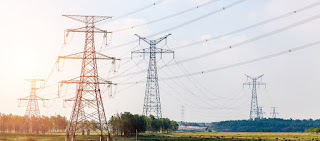New Age Power Sector syatems for 21st Century India – Challenges, Solutions and Opportunities
Power Transmission
is a stage, absence of which can on a very basic level point of confinement the
improvement of a nation. From upgrading expectations for everyday comforts to
taking out neediness, improving wellbeing, expanding efficiency and economy,
power unfetters life.
In India, the power
sector and conveyance arrange navigates through the length and
expansiveness of the nation to connect each family unit, modern offices, a
large group of fundamental enhancements like schools, clinics and so forth., and
the huge breadth of agrarian terrains. The most recent decade saw the power in
India endeavoring to come to the most remote of India’s families in the
remotest of towns. With relentless national endeavors, the nation is at the
edge of 100per penny zap of families. In any case, the bigger objective of the
Government of moderate, secure, '24x7Power All' remaining parts not too far off. Power is essential for the work
of our different, youthful and ambitious population, practical costs and
business feasibility is significant. India has become a force surplus nation,
this is a dream isn't too far away either.
One of the key difficulties in the linkage among electricity
generators and power customers is that the hotspots for power age are not
consistently found across India. Be that as it may, power must be emptied to
arrive at all shoppers. So far warm force age has been more than 80 percent of
India's capacity blend. Be that as it may, renewable
energy sources (RES).
The industry body Confederation of Indian Industry
(CII)launched a white paper titled, "New Age Power Systems For 21st
Century India – Challenges, Solutions and Opportunities", created by
McKinsey and Co. The White Paper has been set up by the Core Group on
Transmission led by Pratik Agarwal,
under the aegis of the National Committee. The White Paper was exhibited to
Shri Ajay Bhalla, Secretary, and Ministry of Power before the official
dispatch.
The White Paper centers on the accompanying momentary
goals for the Power Transmission
division in India and frameworks key significant things for every goal:
· More adaptable transmission arranging: transmission arranging needs to change
from deterministic to expectant (probabilistic)
· Separation of Central Transmission Utility (CTU) from
Power Grid Corporation of India Ltd (PGCIL): The way that CTU is a piece of
PGCIL makes an irreconcilable situation between the job of an organizer and an
engineer
· Tightening of network execution parameters with regards
to expanding sustainable renewable
energy (RE) mix
· Improved unwavering quality of the system by creating
possibilities in the framework
· Compression of venture courses of events from notice to
the beginning of development by 40 percent
· Promotion of innovation
through the more prominent opportunity of plan
· Capacity enlargement of existing transmission framework
· Incorporation of energy
storage solutions as transmission framework component to meet
adaptability necessities
The CII white paper likewise recommends seven independent
necessities that could be considered over the medium-term in a range of three
years. These include:
· State Transmission Utilities (STUs) to make underground
intracity power transmission
compulsory in the best 50 urban areas
· CERC to bring a strategy for shareability and
transferability of long-term open access licensees (LTOA)
· State Electricity Regulatory Commissions (SERCs) to
make an income pooling technique for states (like Central PoC pooling idea)
with the goal that engineers feel progressively great putting resources into
states
· Ministry of Power (MoP) to give rules for required the portrayal of significant power
transmission resource engineers in transmission arranging boards of
trustees like the National Committee on Transmission (NCT) and Regional Power
Committee (RPC) to guarantee a level playing field in the basic leadership process
· CERC to make a structure for the creation and support of an
auxiliary administrations showcase in India
· CEA/MoP to make a system for monetization impression of
urban transmission and dissemination resources
· Facilitate utilization of inventive models of
possession and financing, e.g., Toll-Operate-Transfer (TOT) model



Comments
Post a Comment